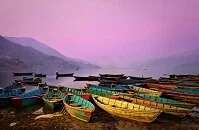Culture & Identity of Nepal
Introduction

Boats on Phewa Lake
Thoughts of Nepal tend to conjure up images of Mt. Everest, the Himalayas, Buddhist prayer flags, and Sherpas. However, these Sherpas, who are often related to the Tibetans, are a very small minority in the country and only 10% of the population is actually Buddhist. About 80% of the people are Hindi and many of these people are more closely related to the nearby people in India than they are to the Tibetans.
More than this, the people of Nepal are quite diverse as there are dozens of ethnic groups in the country. This diversity leads to a great number of cultures and ways of life, but the mountainous landscape contributes greatly to the many similarities in the country.
Over 80% of the people of Nepal are rural and for most of these people (three quarters of the total population) agriculture is how they make a living. Although the high Himalayas have a vastly different farming system than the lower valleys have, the way of life shares many similarities. All these people are reliant on the sun, weather, seasons, and crops that can be grown in their particular region. Among these crops are rice, corn, wheat, beans, peas, lentils, and others.